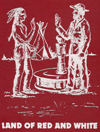 OUR RAILROAD SITUATION (AT THE END OF 1975)
OUR RAILROAD SITUATION (AT THE END OF 1975)
The following information was summarized from articles in the
October 29, 1975 issue of the St. Paul Journal.
On the Prairies, changing traffic patterns have necessitated a long, hard look at branch lines. Abandonment possibilities could lessen and even disappear as western economy grows, especially in northeast Alberta. A rail car carries double the load of a large truck. Why shouldn't rail lines be used to capacity? Aside from the use of air traffic and pipelines, rail lines should be accepted as "the major ingredient of the transportation scene." (Chapter I of H.I. Purdy's "Transport in Canada").
The Government's 1967 National Transportation Act established two types of branch lines: guaranteed lines and unprotected lines. The former were protected to the end of 1974, and no applications for their abandonment could bê made. The railways could claim any resulting losses. Affected were the C.N. Subdivisions of Bonnyville and Coronado, and the C.P. Subdivision of Willingdon. Applications could be made for the abandonment of unprotected lines (Sec. 253 Railway Act), subject to C.T.C. ruling.
A new Government policy, announced on December 23, 1974, established three categories for Prairie railway lines. There was a basic network of over 12,000 miles to be protected until the year 2,000. 6,283 miles were guaranteed until January 1, 1976, and were to be reviewed by regional enquiries to determine future status. 525 miles, no longer in use, were subject to abandonment. In Alberta there are nearly 1500 miles of track in the second category. Of this 580 are C.N., and 810 are C.P. In our area we are concerned with 309 miles. Bonnyville Subdivision (C.N.) 176 miles, Coronado Subdivision (C.N.) 52 miles, and Musidora-Lloydminster (C.P.) 81 miles.
On April 18, 1975, former Supreme Court Justice Emmett Hall was appointed head of a Commission of Inquiry to proceed on a regional basis to examine social and economic aspects surrounding the future of lines protected until January 1, 1976. When the task is completed the Commission will submit recommendations to the Government, specifically to Otto Lang, Minister of Transport.
At meetings already held, the subject of unfinished lines (Heinsburg-Frenchman Butte and Grande Centre-St. Walburg) has come up once again. The idea, in either case, is to obtain a line to Saskatchewan, to open a route to Churchill on the Hudson Bay.
Rail transport is the most efficient means as far as energy consumption, and it moves bulk shipments effectively as well as efficiently. Alternate methods would mean longer producer hauls and an estimated one-half cent per bushel per mile increase in cost. The Coronado and Bonnyville Subdivision lines carry not only grain but fertilizer, chemicals, petroleum products, processed agricultural products, coal, lumber, salt, military equipment and vehicles, farm equipment, rope, flour and clay. Non-grain railway revenue in 1970 was $1,073,271 as compared to $2,591,395 in 1974. For the latter year grain revenue was $551,000. Non-grain tonnage in 1970 was 88,351; in 1973 it was 176,729, and in 1974 was 184,051.
More than four times as many cars were needed in 1974 to move petroleum gas from Redwater than were needed in 1970, and revenue jumped nearly four times in that period, in spite of strikes. Grand Centre showed double revenue on non-grain commodities, while Smoky Lake showed a sixteen-fold increase from 1970 - 1973. The Alfalfa Plant at Mallaig and development in the Oil Sands Corridor through our area will increase traffic. Non-grain traffic movements through Lindbergh have grown steadily, and Mr. Mazankowski* felt that an access line to the east would increase growth even more. An alternative would be a line from Heinsburg to Dewberry to connect with the C.P. Such a connection would increase utilization of the Clover Bar Subdivision, and minimize the prospect of abandonment of the Musidora-Lloydminster line. *M.P. for Vegreville.
Editor's Note: A proposal, under Railway Linkups and New Sections, has been brought forward in the Alberta Legislature. It concerns a thirteen mile line linking Heinsburg and Dewberry, and would involve a cost-sharing agreement between C.N.R. and C.P.R.
A meeting of concerned citizens took place in Heinsburg on Tuesday, November 25, 1975. Trans-Corn staff member, Jack Muza, was present. Two committees were formed to draft a brief to be submitted to the St Paul hearing in January 1976. Before then, their proposals will be presented the community with the possiblity that additional ideas will be brought forth.
G. Anand, Heinsburg teacher, assisted in the drafting of the brief which was presented at St. Paul on January 15, 1976. Presiding commissioners were Hon. Emmett M. Hall, Q.C. and Reiny Lehr. CNR and numerous groups were represented.


